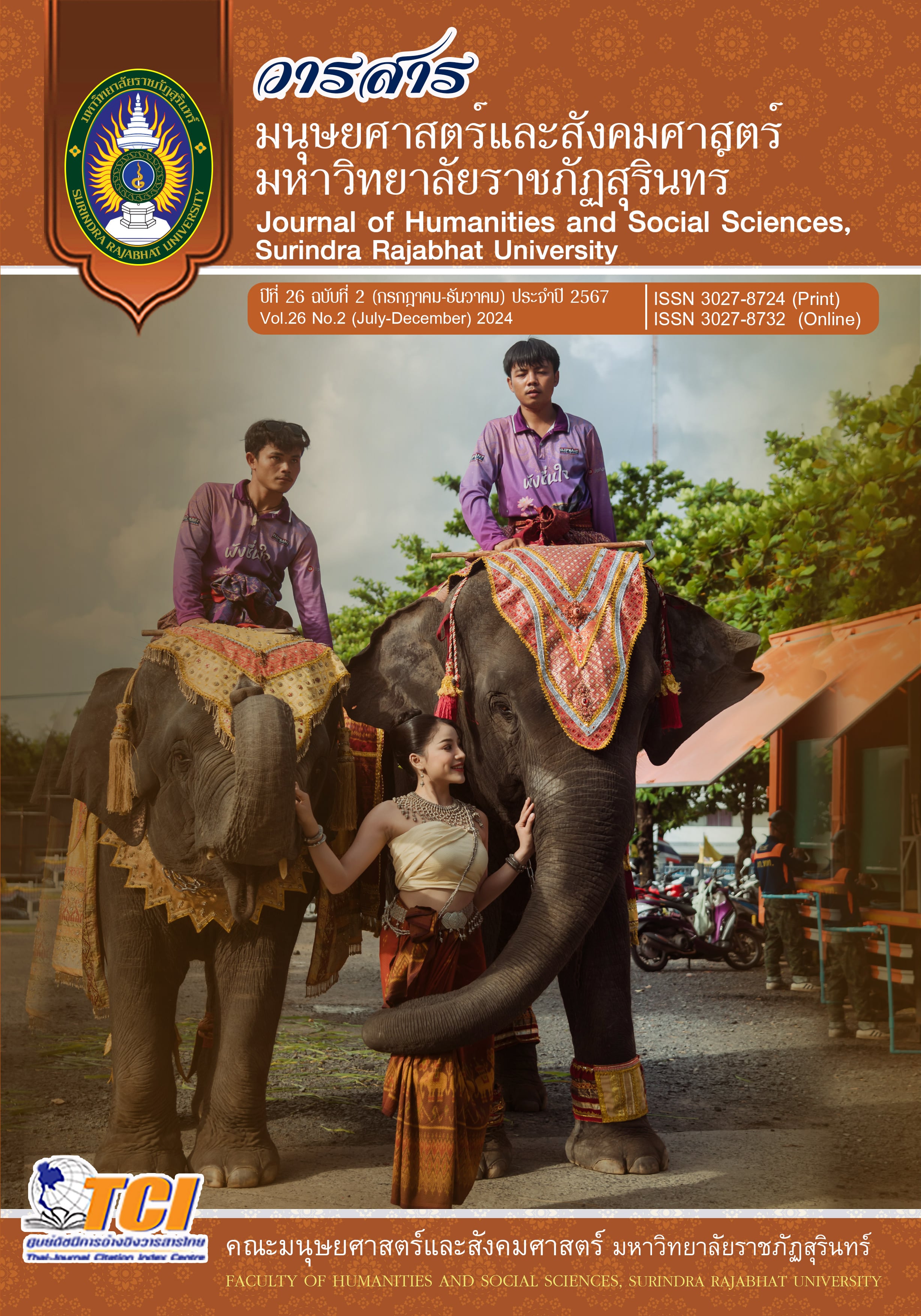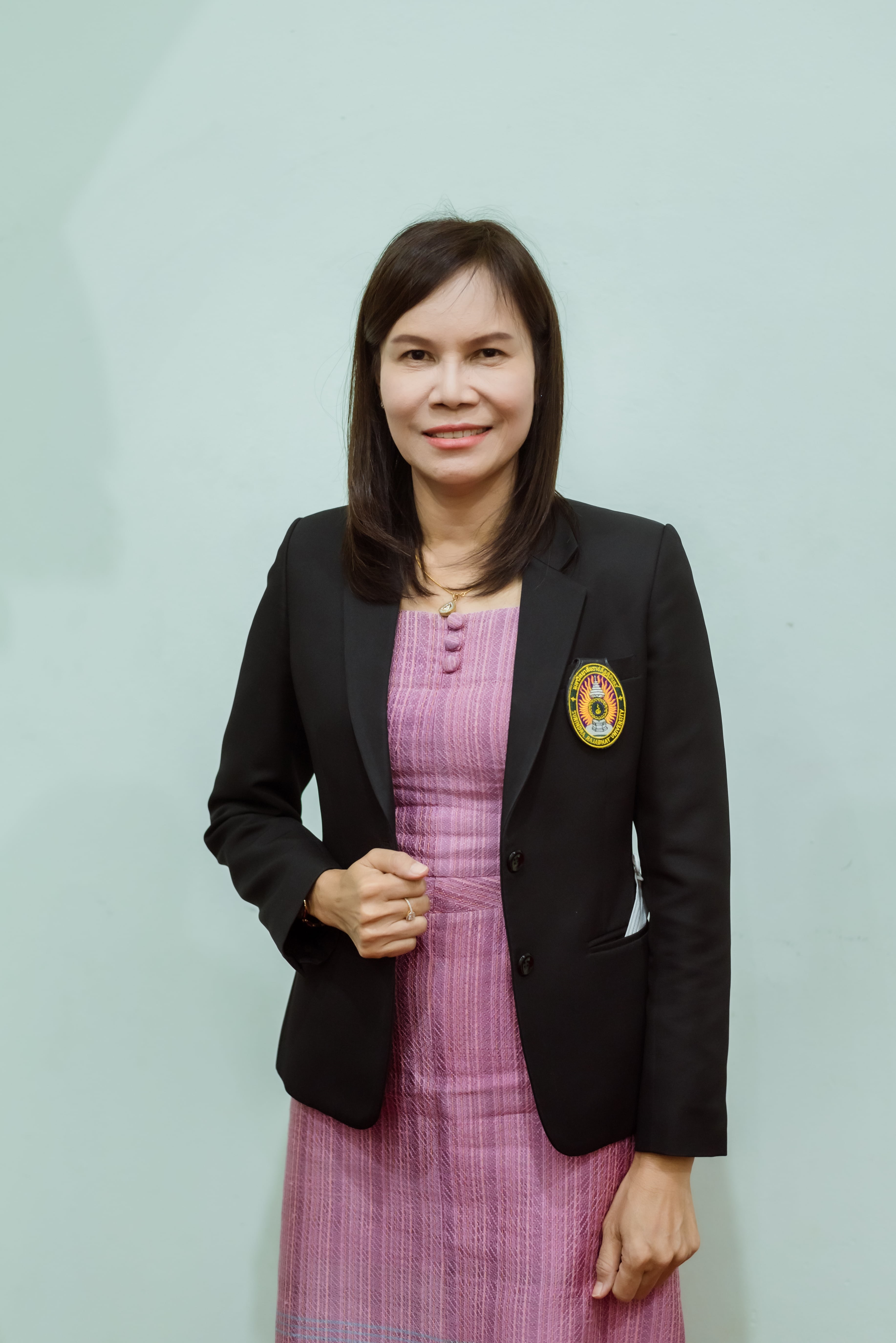The Development of Instructional Package by Using an Instructional Model Based on Simpson’s Process for Psycho-Moter skill development through Community Learning Base on the topic of Forn Satta Bru Cha Pra That Ban Prasat for matayomsuksa 5 students
Keywords:
Learning activity set, Community-based teaching, Simpson's 7 practical skills stepAbstract
The objectives of this research were to: 1) study the traditions of the Phra That worship in Ban Prasat, Prasat Sub-district, Huai Thap Than District, Sisaket Province; 2) develop a learning activity set; 3) compare students' learning achievement before and after participating in the activities, and compare it to the benchmark of 80%; and 4) study students' opinions regarding the learning activity set. The research was of the development type. The sample group for the study consisted of 36 students from Grade 11/3 in the first semester of the 2024 academic year at Huai Thap Than Witthayakhom School, Sisaket Province, selected through stratified random sampling, as well as 38 key informants, including 10 knowledgeable individuals, 20 practitioners, and 8 experts. The research instruments included interview questions, focus group discussion guidelines, focus group discussion records, learning activity sets, a guide for conducting learning activities, and a questionnaire on students' opinions of the learning activities. The IOC values for the instruments ranged from 0.68 to 1.00, with a content validity index of 0.91, indicating that the instruments were valid for data collection. The data were analyzed qualitatively through content analysis of the interviews and focus group discussions, and quantitatively using descriptive statistics (mean, standard deviation) and hypothesis testing with dependent t-tests via software.
The research results concluded that: 1) The situation of the Phra That worship tradition in Ban Prasat, Prasat Sub-district, Huai Thap Than District, Sisaket Province, can be divided into six issues: the history of Phra That Ban Prasat, the history and components of the Phra That worship tradition, the context of Ban Non That, the roles and values of the Phra That worship tradition, the current state of the Phra That worship tradition, and approaches for preserving, revitalizing, and promoting the tradition. 2) The developed learning activity set had an efficiency index (E1/E2) of 88.39/87.05, which was higher than the established benchmark. 3) The students' learning achievement after the lesson was higher than before, and it exceeded the benchmark of 80% with statistical significance at the 0.05 level. 4) Students' overall opinion of the learning activity set was highly positive (mean = 4.51). When considering individual aspects, the mean scores were all high : introduction section (mean = 4.60), general components (mean = 4.58), content (mean = 4.50) presentation format (mean = 4.50), interaction among students in group activities (mean = 4.49), and knowledge and experience (mean = 4.49).
Downloads
References
กระทรวงศึกษาธิการ. (2551). ตัวชี้วัดและสาระการเรียนรู้แกนกลางกลุ่มสาระการเรียนรู้ศิลปะตามหลักสูตรแกนกลางการศึกษาขั้นพื้นฐาน พุทธศักราช 2551. กรุงเทพฯ : ชุมนุมสหกรณ์การพิมพ์.
เจริญ ทองไหม. (2563, กรกฎาคม 9). ปลัดองค์การบริหารส่วนตำบลปราสาท. สัมภาษณ์.
ชรินทร์ แปลกจิตร. (2563, กรกฎาคม 9). ปราชญ์ท้องถิ่น. สัมภาษณ์.
ชัยยงค์ พรหมวงศ์ และคนอื่น ๆ. (2545). ระบบสื่อการสอน. กรุงเทพฯ : จุฬาลงกรณมหาวิทยาลัย.
ชาติชาย สร้อยดอกสน. (2562). ผลการใช้บทเรียนเรื่อง ศิลปะการป้องกันตัว แบบไอคิโดโดยใช้แนวคิดการพัฒนาทักษะปฏิบัติของซิมพ์ซัน สำหรับนักเรียนชั้นประถมศึกษาปีที่ 6. วิทยานิพนธ์ปริญญาการศึกษามหาบัณฑิต สาขาหลักสูตรและการสอน บัณฑิตวิทยาลัย มหาวิทยาลัยบูรพา.
ชลธิชา ไหมทอง, อิทธิวัตร ศรีสมบัติ และสิริพัฒถ์ ลาภจิตร. (2566). การจัดการเรียนรู้ด้วยวิธีการทางประวัติศาสตร์ โดยใช้แหล่งเรียนรู้ปราสาทศีขรภูมิ. วิทยานิพนธ์ปริญญาครุศาสตรมหาบัณฑิต สาขาสังคมศึกษา มหาวิทยาลัยราชภัฎสุรินทร์.
บุสรินทร์ พาระแพน. (2561). การพัฒนาชุดการเรียนรู้การแสดงนาฏศิลป์พื้นบ้าน ตามแนวคิดทักษะปฏิบัติของซิมพ์ซัน ที่ส่งเสริมบุคลิกภาพและความคิดสร้างสรรค์การปฏิบัติท่ารำ นักเรียนชั้นมัธยมศึกษาปีที่ 3. วิทยานิพนธ์ปริญญาการศึกษาศาสตรมหาบัณฑิต สาขาวิชาหลักสูตรและการสอน บัณฑิตวิทยาลัย มหาวิทยาลัยมหาสารคาม.
มงคล คมขำ. (2559). การพัฒนาชุดกิจกรรมการเรียนรู้โดยใช้รูปแบบการเรียนการสอนที่เน้นทักษะปฏิบัติ เรื่องการตัดสินกีฬาวอลเลย์บอลสำหรับนักศึกษาชั้นปีที่ 2 คณะศึกษาศาสตร์ สถาบันการพลศึกษาวิทยาเขตศรีสะเกษ. วิทยานิพนธ์ปริญญาครุศาสตรมหาบัณฑิต สาขาวิชาการพัฒนาหลักสูตรและการเรียนการสอน มหาวิทยาลัยราชภัฎอุบลราชธานี.
วิรดี จินตะไล. (2561, มิถุนายน). “การจัดกิจกรรมการเรียนรู้นาฏศิลป์เพื่อพัฒนาทักษะการปฏิบัติตามแนวคิดของซิมพ์ซัน ของนักเรียนชั้นประถมศึกษาปีที่ 2 โรงเรียนเทศบาลบ้านศรีมหาราชา.” วารสารพัฒนศิลป์วิชาการ. ฉ.พิเศษ : 97-111.
สำนักงานคณะกรรมการวัฒนธรรมแห่งชาติ. (2551). คู่มือการจัดตั้งสภาวัฒนธรรมตำบลและหมู่บ้าน. กรุงเทพฯ : ชุมชนสหกรณ์การเกษตรแห่งประเทศไทย.
สำนักงานเลขาธิการสภาการศึกษา. (2560). แผนการศึกษาแห่งชาติ พ.ศ. 2560-2579. กรุงเทพฯ : พริกหวานกราฟฟิค.
สุรชาติ พานทอง. (2563, กรกฎาคม 9). เจ้าพนักงานส่งเสริมการท่องเที่ยวองค์การบริหารส่วนตำบลปราสาท. สัมภาษณ์.
เสถียร ยอดนิล และคนอื่น ๆ. (2563, กรกฎาคม 9). ปราชญ์ท้องถิ่นบ้านโนนธาตุ. สัมภาษณ์.
ศศิบุษย์ บุราคร, อิทธิวัตร ศรีสมบัติ และสิริพัฒถ์ ลาภจิตร. (2566). การจัดการเรียนรู้เรื่องชื่นชมและบอกแบบอย่างการดำเนินชีวิตและประวัติจากประวัติสาวกชาดก กลุ่มสาระการเรียนรู้สังคมศึกษา ศาสนาและวัฒนธรรม นักเรียนชั้นประถมศึกษาปีที่ 1 ด้วยการสอนแบบบทบาทสมมุติร่วมกับการใช้หนังสือประกอบภาพระบายสี. วิทยานิพนธ์ปริญญาครุศาสตรมหาบัณฑิต สาขาสังคมศึกษา มหาวิทยาลัยราชภัฎสุรินทร์.
องค์การบริหารส่วนตำบลปราสาท. (2563). แผนพัฒนาท้องถิ่น (พ.ศ. 2566-2570). ศรีสะเกษ : องค์การบริหารส่วนตำบลปราสาท.
อมรรัตน์ เทพกำปนาท. (2552). ความหมาย และแนวคิดเกี่ยวกับประเด็นวัฒนธรรม. กรุงเทพฯ : สำนักงานคณะกรรมการวัฒนธรรมแห่งชาติ กระทรวงวัฒนธรรม.
อุไรวรรณ เจือจันทร์. (2560). การเปรียบเทียบวิธีการสอนแบบปกติกับวิธีการสอนทักษะปฏิบัติของซิมพ์ซัน (Simpson) โดยใช้ชุดฝึกทักษะปฏิบัตินาฏศิลป์พื้นเมืองสร้างสรรค์ด้วยเพลงเที่ยวเมืองสุรินทร์ กลุ่มสาระการเรียนรู้ศิลปะ สาระที่ 3 นาฏศิลป์ ของผู้เรียนชั้นประถมศึกษาปีที่ 4. สุรินทร์ : โรงเรียนเมืองสุรินทร์.
Simpson, D. (1972). Teaching Physical Education : A System Approach. Boston : Houghton Mufflin Co.











